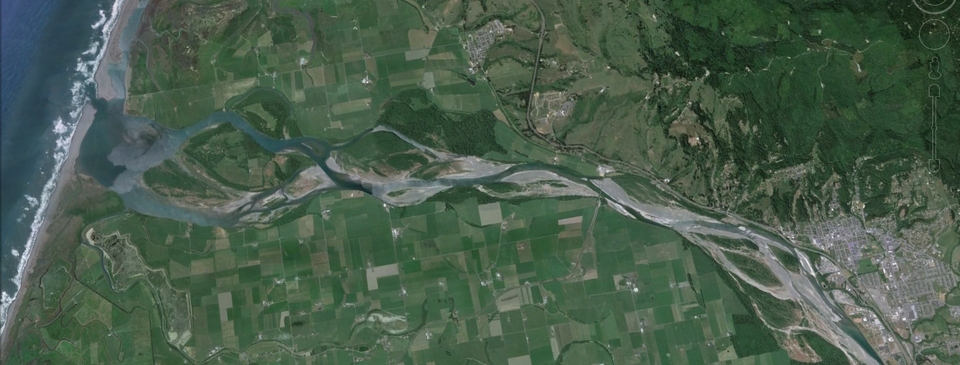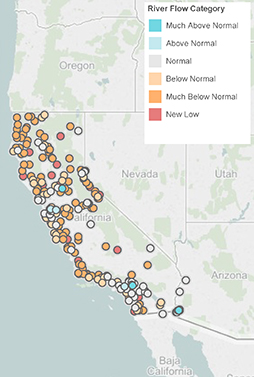Drought Impacts

California Drought – Protecting Salmon NOAA Fisheries, the California Department of Fish & Wildlife, water control agencies and private landowners come together to find ways to ration water for endangered salmon survival during the California drought. August 8, 2015.
Chinook salmon eggs didn’t hatch – Hatchery fish come to rescue Since the drought increased the temperature of the Sacramento River eggs didn’t hatch. Now, fish from hatcheries are coming to the aid. February 2015
Racing to save Scott River coho With a historic drought this summer, the California Department of Fish and Wildlife are on an unprecedented rescue mission to net and evacuate as many of the fabled Coho salmon in the drought-parched streams as possible. August 2014.
The Eel River has stopped flowing After seeing the lowest ever winter flows this past January,now there is disconnected flow on the Eel at Fortuna. Once a stronghold of salmon and a defining piece of our north coast heritage, the mighty Eel is hurting. September 2014.
Eel River in crisis Aerial survey of the upper Eel River. September 2014.
Salmon migrate to ocean by truck In drought-stricken California, young Chinook salmon are hitting the road, not the river, to get to the Pacific Ocean. Millions of smolts are hitching rides in tanker trucks because the annual migration to the ocean is too dangerous for them. June 2014.
Salmon in Low Water Conditions – Mattole River Without significant rainfall since late September 2013, Chinook salmon are stranded in many of the pools of the lower Mattole river. Watch this school of at least 50 large Chinook swim back and forth.
Late December 2013 video by Thomas Dunklin
Thirsty for Change?
California’s drought is the wake-up call to get serious about solving our water problems. We need a solution to fill our rivers, streams and wetlands when nature needs it, and provides adequate water so our farms and cities prosper. Today, rivers are running dry, and water is sucked from wells in the ground faster than it is replenished.
State and Federal Agency Actions
The California Department of Fish and Wildlife (CDFW) is acting quickly to preserve and protect our state’s salmon and steelhead, and the water salmon need to survive. Visit the CDFW drought page and the CDFW Drought Response Projects page to learn more.
Fish Rescues
- Redwood Creek Coho Salmon Rescue and Captive Rearing Project (2014-2018)
- US Bureau of Reclamation Releases Additional Water to Address Fish Health in Lower Klamath River (September 16, 2014)
- Scott River Fish Rescue and Relocation (Second article with more photos) (August 21, 2014)
- Merced River Steelhead Rescue (July 2014)
- Sacramento River fall-run Chinook hatchery-raised salmon smolts trucked to San Francisco Bay (April 7, 2014)
Voluntary Drought Initiative
CDFW and NOAA Fisheries jointly introduced a Voluntary Drought Initiative to protect populations of salmon and steelhead. Water users can enter individual agreements with CDFW and NOAA Fisheries to maintain enough water for fish spawning in specific high priority streams, and implement other collaborative actions like fish rescue, relocation, monitoring and habitat restoration. The Scott River Fish Rescue (see above) is an exemplary result.
In April 2015, CDFW and the State Water Resources Control Board put out a request to landowners in Green Valley, Dutch Bill, Mark West and Mill Creeks, tributaries to the Russian River, Sonoma County to participate in voluntary drought agreements to ensure enough instream water for endangered coho.
Emergency Tank Storage Registration in Response to Drought
CDFW and the State Water Resources Control Board jointly introduced a Small Domestic Use Storage Tanks Expedited Permitting to expedite approval for the installation of storage tanks by landowners who currently divert water from the state’s coastal rivers and streams. These streams are in danger of reaching critically low stages during the summer, threatening rural drinking water supplies. Capturing rain and storing in rainwater tanks for use later can also help reduce the impacts to fish and wildlife from diverting water from streams during the driest times of the summer.
CDFW Drought Funding
With drought funding, CDFW has implemented a variety of drought actions for salmon, including increased monitoring of fish in the Sacramento River basin and work with NMFS and USFWS to complete restoration and fish passage projects in the Upper Sacramento River. Increased funding under the Fisheries Restoration Grant Program were also made available.
Stream Flow Monitor

What You Can Do
Reduce Water Use
We can all do our part to reduce our water use – visit saveourwater.com
Resources
- State of California’s Drought
- Current Water Conditions
- California Institute of Water Resources
- California Drought Watch – by UC Davis
- USGS WaterWatch – Map of streamflow compared to historical streamflow in California